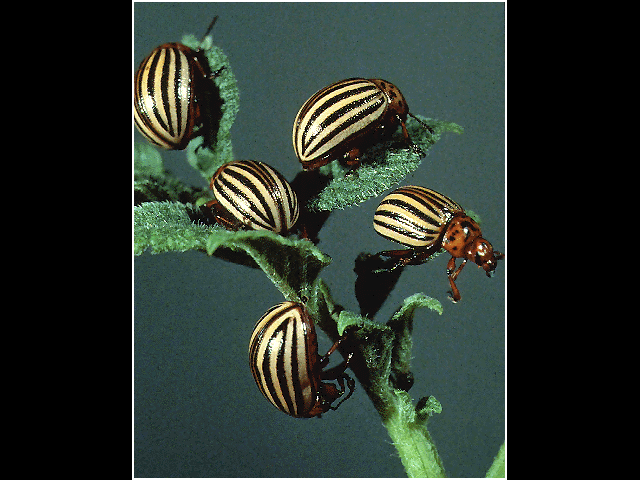Explore
- BugInfo
- Fun Facts About Bugs
- Incredible Insects
- Numbers of Insects
- Benefits of Insects
- Insects as Food for Humans
- Diseases Caused by Insects
- Insects in Winter
- Insect Flight
- Mating in Insects
- Pheromones
- Insects as Pets
- Backyard Bugs
- True Flies
- Wasps, Ants, and Bees
- Africanized Bees
- Carpenter Ants
- Cicada Killer Wasps
- Beetles
- Butterflies
- Butterflies in the U.S.
- Monarch Butterflies
- Drawing Insects
- True Bugs
- Insect and Mite Galls
- Science Fair Projects
- State Insects
- Moths
- Gypsy Moths
Beetles (Coleoptera)
Numbers of species. Beetles (Order Coleoptera) are known to include some 350,000 described species. In the United States, there are nearly 30,000 kinds of beetles known. These figures are rising constantly due to the naming of new species by taxonomists.
Size. Beetles vary from species that are barely visible (especially the Feather-winged beetles), to large tropical species that are the size of a human hand. Titanus giganteus, a long-horned beetle from South America, is usually considered to be the largest known beetle.
Food. Beetles are such a large, diverse group that they have representatives that eat nearly every kind of food. They feed on all parts of living or dead land plants. Some are excellent hunters and predators. Some are scavengers and a few are parasitic.
Habitats. Habitats of beetles on land are numerous. Many are on the ground or under material on the ground. Different kinds can be found on vegetation, in rotting wood or plants, in carrion, fungi, and dung. Some are aquatic, living in bodies of water that range from small puddles to cold mountain streams, and a few are parasitic. They are found in dry deserts and in the cold temperatures of mountain tops.

From the Insect Zoo at the Smithsonian's National Museum of Natural History.
Smithsonian Photo by Chip Clark. (c) 1991 Smithsonian Institution.
Benefits of beetles. Beetles are of value to humans in many ways. They are prominent decomposers, especially in forests. As predators, they reduce populations of problem insects, especially caterpillars. Ladybird beetles are widely known to be important predators of aphids, and can be purchased commercially for this purpose.
Detriments of beetles. A small percentage of beetles can be said to be harmful to products of humans. Some bark beetles kill thousands of trees in western forests each year. Agriculture in the United States is in constant threat of serious beetle pests, the prime examples being the Cotton Boll Weevil and the various species of Rootworms. Many stored foods are ruined, these including meats, dairy products, flour, meal, cereals, stored grain, nuts, and fruits.
Varieties of beetles. Weevils (Curculionidae) constitute the largest family of beetles, and are arguably the largest Family of insects. Other large Families of beetles are the Darkling Beetles (Tenebrionidae), Ground Beetles (Carabidae), Leaf Beetles (Chrysomelidae) , Long-horned Beetles (Cerambycidae) , Scarab Beetles (Scarabaeidae), Click Beetles (Elateridae), and Rove Beetles (Staphylinidae). There are approximately 100 Families of beetles in the United States.
Prized by Collectors. The beauty, size and variety of beetles cause them to be very popular among collectors of items from nature. Especially valued by collectors are large, tropical species of buprestid (Buprestidae) and long-horned (Cerambycidae) beetles. Scarab (Scarabaeidae) beetles are sometimes remarkably colorful with attractive patterns also.
Shapes. The variations of shapes in beetle species are remarkable. There are large beetles found in fungi with bodies that resemble violins. Snail-eating beetles have long "necks" to invade snail shells. Aquatic beetles have bodies (and legs) designed for swimming.
Selected References:
Arnett, R. H. 1968. The Beetles of the United States (A Manual for Identification). American Entomological Institute, Ann Arbor, Michigan.
Arnett, R. H., Downie, N. M., & Jaques, H. E. 1980. How to Know the Beetles. Wm. C. Brown Co., Dubuque, Iowa.
Dillon, E. S. & Dillon, L. S. 1961. A Manual of Common Beetles of Eastern North America. Row, Peterson and Co., Evanston, Illinois.
Downie, R. H. & Arnett, R. H. 1996. The Beetles of Northeastern North America, Volumes 1 and 2. Sandhill Crane Press, Gainesville, Florida.
Evans, A. & Bellamy, C. 1997. An Inordinate Fondness for Beetles. H. Holt & Co., New York.
White, R. E. 1983. A Field Guide to the Beetles of North America. Houghton Mifflin, Boston.
Prepared by the Entomology Section, Dept. of Systematic Biology
National Museum of Natural History, in cooperation with Public Inquiry Services,
Smithsonian Institution
Information Sheet Number 177. 1996
